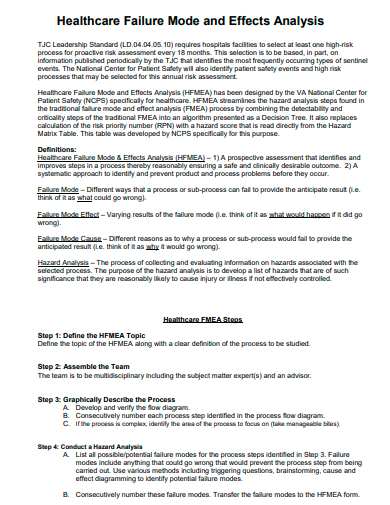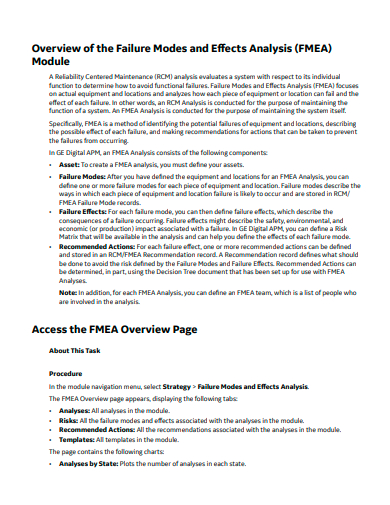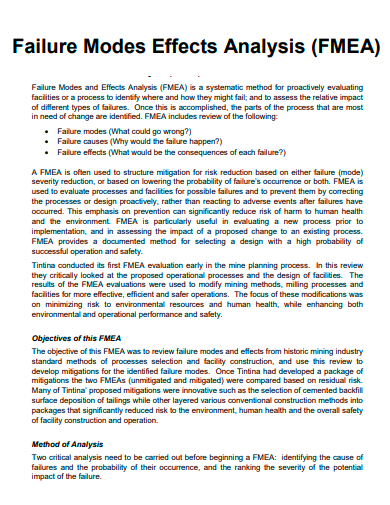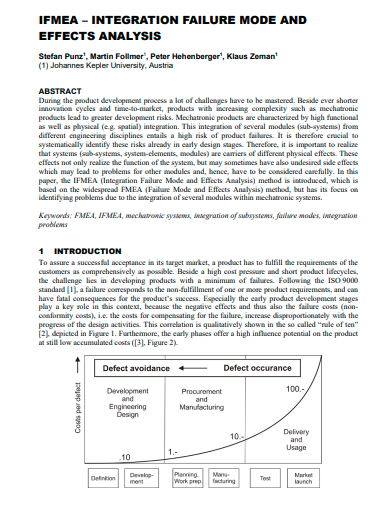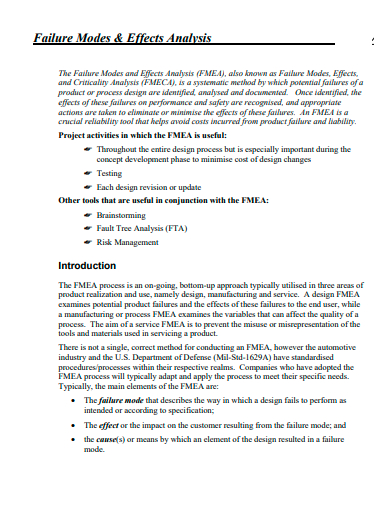The FMEA process begins by defining the process flow or agile product that will be evaluated. The next step is to identify all potential failure modes for each step in the process. A failure mode is a specific way in which a product or process can fail to meet its intended purpose. For each failure mode, the team will identify the potential causes, the effects of the failure on the business process or end-customer, and the severity of the impact.
FREE 10+ Failure Mode and Effects Analysis Samples
1. Failure Mode and Effects Analysis Template
2. Healthcare Failure Mode and Effects Analysis
3. Failure Mode and Effects Analysis Module
4. Formal Failure Mode and Effects Analysis
5. Human Factors Informed Failure Mode and Effects Analysis
6. Failure Mode and Effects Analysis Example
7. Printable Failure Modes Effects Analysis
8. Integration Failure Mode and Effects Analysis
9. Failure Mode and Effects Analysis in PDF
10. Sample Failure Mode and Effects Analysis
11. Failure Mode and Effects Analysis Format
What is Failure Mode and Effects Analysis?
Failure Mode and Effects Analysis (FMEA) is a systematic, proactive method for evaluating a process to identify where and how it might fail and to assess the relative impact of different failures, in order to identify the parts of the process that are most in need of change. The goal of FMEA is to ensure that failures are detected and corrected as early as possible in the design or manufacturing process, before they reach the customer or cause harm. The process involves examining each step in a process and identifying potential failures, the causes of those failures, and the effects of the failures on the overall process and end-customer. The results of an FMEA can be used to prioritize process improvements and reduce the risk of failures in the future.
How To Make a Failure Mode and Effects Analysis?
The FMEA process is iterative, and the team will continue to refine their understanding of the process and the potential failures as they move through the path analysis. This allows them to identify and correct potential failures before they occur, reducing the risk of harm to the end-customer and improving the overall quality of the process or product. Here is a step-by-step guide for conducting a Failure Mode and Effects Analysis (FMEA):
Step 1- Define the Scope of Work
This includes identifying the process, product, or system that will be evaluated and defining its boundaries. This helps to ensure that the FMEA is focused and relevant. Assemble a cross-functional team to have expert tips with a good understanding of the process, product, or system. This will ensure that the FMEA is thorough and accurate.
Step 2- Create the Process Flow
Document the process steps and the interconnections between them. This will help the team to visualize the process and identify potential failure modes. For each process step, list all potential failure modes and their causes. A failure mode is a specific way in which a product or process can fail to meet its intended purpose.
Step 3- Evaluate the Severity
Assess the impact of each failure mode on the process, product, or system and on the end-customer. The severity of the effect can be rated on a scale, such as 1 to 10, where 10 represents the highest impact.
Step 4- Determine the Occurence
Determine the likelihood that each failure mode will occur based on past experience, testing, or expert judgment. This can also be rated on a scale, such as 1 to 10, where 10 represents the highest likelihood of occurrence.
Which FMEA success factors are most crucial?
A successful FMEA methodology, strong executive sponsorship request, best-practice FMEA implementation, and sufficient FMEA resources are essential to FMEA success in any firm.
FMEA review frequency?
A systematic FMEA evaluation throughout the vessel’s life cycle should be done at least every five years.
What steps reduce FMEA severity? Eliminating a Failure Mode or its Effect can address its Severity.
What steps reduce FMEA severity? Eliminating a Failure Mode or its Effect can address its Severity.
Teams can use FMEA to review processes for the possibility of failure and to prevent failures from occurring by making proactive adjustments to the processes rather than responding to unfavorable events that have already taken place after failures have taken place. Because of this emphasis on prevention, the risk of injury to both patients and staff members may be reduced.
Related Posts
FREE 11+ Cost Volume Profit Analysis Samples & Templates in PDF | MS Word
FREE 6+ Corporate Portfolio Analysis Samples in PDF
FREE 10+ Fault Tree Analysis Samples in PDF
FREE 10+ Comp Analysis Samples in PDF
FREE 10+ Fishbone Analysis Samples in PDF
FREE 10+ Individual Swot Analysis Samples in PDF
FREE 10+ 5 Year Analysis Samples in PDF
FREE 10+ Benefit Costs Analysis Samples in PDF
FREE 10+ Job Hazard Analysis Samples in PDF
FREE 10+ Primary Source Analysis Samples in PDF
FREE 10+ Critical Path Analysis Samples in PDF
FREE 10+ Competition Analysis Samples in PDF
FREE 10+ Activity Hazard Analysis Samples in PDF
FREE 10+ Risk Benefit Analysis Samples in PDF
FREE 10+ SEO Competitor Analysis Samples in PDF


